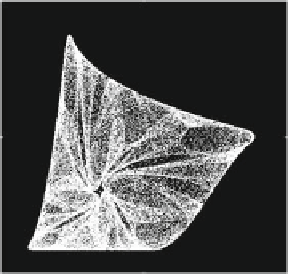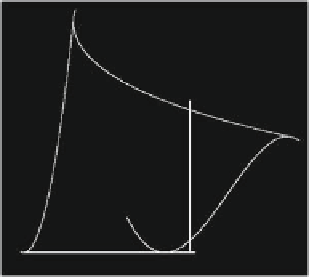Chemistry Reference
In-Depth Information
0.7
y
0.7
y
LC
2
P
LC
1
LC
−1
LC
3
LC
P
'
-1.6
-1.6
x
-1.6
x
1
-1.6
1
(a)
(b)
Fig. C.7
Delineating the absorbing area of the two-dimensional map given in (C.5). Here a
D
1:4.(
a
) A chaotic trajectory of the map. (
b
) The boundary of the absorbing
area formed by the critical line and three of its iterates. The location of the starting line LC
1
is
discussed in the text
0:3 and b
D
Indeed, following Mira et al. (1996) (see also Bischi and Gardini (1998)) a prac-
tical procedure can be outlined for obtaining the boundary of an absorbing area
(although it is difficult to give a general method). Starting from a portion of LC
1
,
approximately located in the region occupied by the area of interest, compute its
images under T of increasing rank until a closed region is obtained. When such a
region is mapped into itself, then it is an absorbing area
A
. The length of the ini-
tial segment is to be set, in general, by a trial and error method, although several
suggestions are given in the topics referenced above. Once an absorbing area
is
found, in order to see if it is invariant or not the same procedure must be repeated
by taking only the portion
A
D
A
\
LC
1
(C.12)
as the starting segment. Then one of the following two cases occurs:
Case 1. The union of m iterates of (for a suitable m) covers the whole boundary
of
A
I
in which case
A
is an invariant absorbing area, and
m
[
T
k
./
@
A
(C.13)
k
D
1
Case 2. No natural m exists such that
S
kD1
T
k
./ covers the whole boundary of
A
I
in which case
is not invariant but strictly mapped into itself. An invari-
ant absorbing area is obtained by
\
n>0
T
n
.
A
A
/ (and may be obtained by a
finite number of images of
A
).
The application of this procedure to the problem of the delineation of the chaotic
area of Fig. C.7a by portions of critical curves suggests, on the basis of Fig. C.7b,


Search WWH ::

Custom Search